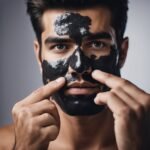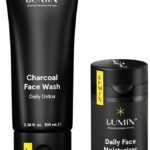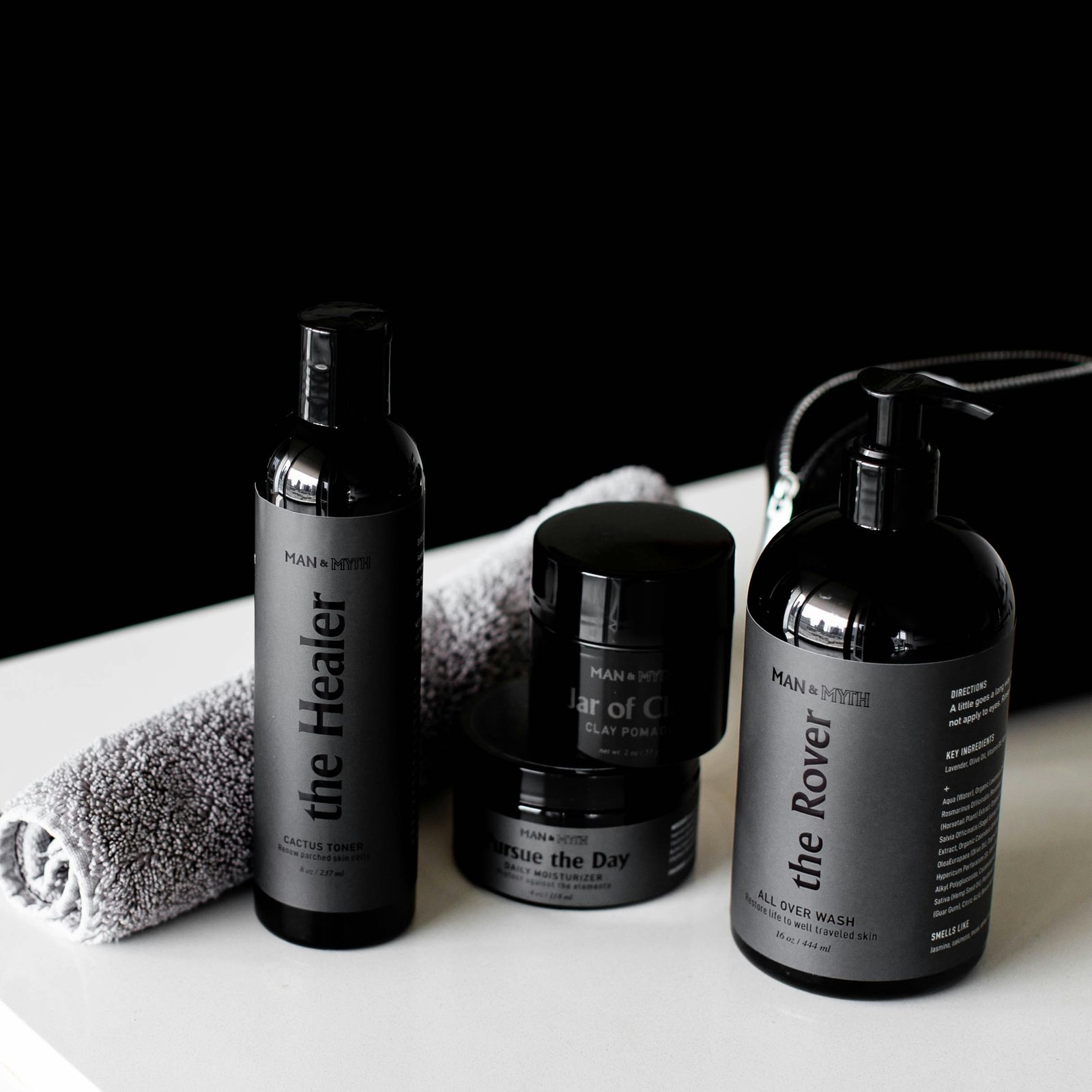Men’s skincare has become increasingly important in recent years. A proper routine can help maintain healthy, youthful-looking skin and prevent common issues like dryness, acne, and premature ageing. Many men are unsure where to start with skincare or which products to use.

A comprehensive skincare routine for men typically includes cleansing, exfoliating, moisturising, and sun protection. Each step serves a specific purpose in keeping skin clean, hydrated, and protected from environmental damage. With the right products and techniques, even skincare novices can achieve noticeable improvements.
This guide will break down a step-by-step skincare routine tailored for men’s needs. It will cover product recommendations, application methods, and tips for addressing specific skin concerns. By following these steps consistently, men can develop an effective skincare habit that fits easily into their daily lives.
Understanding Skin Types
Knowing your skin type is crucial for effective skincare. It helps determine which products and routines will work best for your complexion.
Identify Your Skin Type
Skin types generally fall into five categories: normal, dry, oily, combination, and sensitive. To determine your skin type, cleanse your face and wait an hour without applying any products. Observe how your skin feels and looks.
Normal skin feels balanced and comfortable, with few imperfections. Dry skin may feel tight or flaky, lacking oil. Oily skin appears shiny and may have enlarged pores. Combination skin is dry in some areas (typically cheeks) and oily in others (usually the T-zone).
Sensitive skin reacts easily to products or environmental factors, often with redness or irritation.
Common Characteristics
Normal skin: Even texture, no visible pores, and a healthy glow.
Dry skin: Rough texture, flakiness, and potential redness or irritation.
Oily skin: Shiny appearance, prone to breakouts, and enlarged pores.
Combination skin: Oily T-zone (forehead, nose, chin) with drier cheeks.
Sensitive skin: Easily irritated, may sting or burn with certain products.
Understanding these characteristics helps in selecting appropriate skincare products and routines tailored to your specific needs.
Daily Skincare Routine
A consistent daily skincare routine is essential for maintaining healthy, clear skin. It involves cleansing, moisturising, and protecting the skin from harmful UV rays.
Cleansing
Cleansing is the foundation of any effective skincare routine. Men should wash their face twice daily, in the morning and evening, using a gentle cleanser suited to their skin type.
For oily or acne-prone skin, opt for a foaming cleanser with salicylic acid or benzoyl peroxide. Those with dry or sensitive skin should choose a cream-based cleanser with hydrating ingredients like glycerin or ceramides.
Apply the cleanser using circular motions, focusing on areas prone to oil buildup such as the T-zone. Rinse thoroughly with lukewarm water and pat dry with a clean towel.
Moisturising
After cleansing, apply a moisturiser to hydrate and protect the skin. Choose a lightweight, non-comedogenic formula for oily skin, or a richer cream for dry skin.
Look for ingredients like hyaluronic acid, which helps retain moisture, or niacinamide, which can improve skin texture and reduce redness. For those with sensitive skin, fragrance-free options are best.
Apply a small amount of moisturiser to the face and neck, gently massaging it in until absorbed. Use upward motions to promote circulation and prevent dragging the skin downwards.
Sun Protection
Sun protection is crucial for preventing premature ageing and reducing the risk of skin cancer. Apply a broad-spectrum sunscreen with at least SPF 30 every morning, even on cloudy days.
Choose a lightweight, non-greasy formula that won’t clog pores. Look for physical sunscreens containing zinc oxide or titanium dioxide for sensitive skin.
Apply sunscreen generously to all exposed areas, including the face, neck, and ears. Reapply every two hours when outdoors or after swimming or sweating. Consider using a moisturiser with built-in SPF to simplify your routine.
Exfoliation and Treatments
Proper exfoliation and targeted treatments are essential components of an effective men’s skincare routine. These steps help remove dead skin cells, unclog pores, and address specific skin concerns.
Regular Exfoliation
Exfoliation should be performed 1-2 times per week, depending on skin type. For physical exfoliation, use a gentle scrub with small, round particles. Apply the product in circular motions, focusing on areas prone to congestion like the nose and forehead.
Chemical exfoliants, such as alpha-hydroxy acids (AHAs) or beta-hydroxy acids (BHAs), offer an alternative method. These products work by dissolving the bonds between dead skin cells, revealing fresher skin underneath.
After exfoliating, rinse thoroughly with lukewarm water and pat the skin dry. Follow up with a moisturiser to replenish hydration.
Targeted Treatments
Targeted treatments address specific skin concerns and should be applied after cleansing but before moisturising. For acne-prone skin, look for products containing salicylic acid or benzoyl peroxide.
To combat signs of ageing, opt for serums with ingredients like retinol, vitamin C, or peptides. These help stimulate collagen production and reduce the appearance of fine lines.
For men with sensitive or dry skin, hydrating treatments with hyaluronic acid or ceramides can provide much-needed moisture. Apply a small amount of product to the face and neck, gently patting it into the skin.
Consistency is key when using targeted treatments. Results may take several weeks to become noticeable, so patience and regular use are crucial.
Lifestyle Considerations
A comprehensive skincare routine goes beyond topical products. Healthy habits in diet, sleep, exercise, and stress management play crucial roles in achieving and maintaining clear, vibrant skin.
Diet and Hydration
Proper nutrition and hydration are essential for healthy skin. A balanced diet rich in fruits, vegetables, lean proteins, and healthy fats provides vital nutrients that support skin health. Omega-3 fatty acids, found in fish, flaxseeds, and walnuts, help maintain skin elasticity and reduce inflammation.
Antioxidant-rich foods like berries, dark leafy greens, and green tea protect skin cells from damage. Vitamin C, present in citrus fruits and bell peppers, supports collagen production. Staying hydrated is equally important. Aim for at least 8 glasses of water daily to keep skin plump and flush out toxins.
Limit intake of processed foods, sugary snacks, and alcohol, as these can contribute to skin inflammation and premature ageing.
Sleep and Exercise
Quality sleep is crucial for skin repair and regeneration. Aim for 7-9 hours of sleep per night to allow your body time to produce collagen and repair cellular damage. Establish a consistent sleep schedule and create a relaxing bedtime routine to improve sleep quality.
Regular exercise promotes healthy circulation, which delivers oxygen and nutrients to skin cells. It also helps regulate hormones and reduces stress, benefiting overall skin health. Aim for at least 150 minutes of moderate-intensity exercise per week.
Remember to cleanse your face after workouts to remove sweat and bacteria that can clog pores.
Stress Management
Chronic stress can wreak havoc on your skin, triggering breakouts, exacerbating existing skin conditions, and accelerating ageing. Implement stress-reduction techniques into your daily routine:
• Meditation or mindfulness practices • Deep breathing exercises • Yoga or gentle stretching • Hobbies or activities you enjoy
Consider keeping a journal to identify and address stress triggers. Time management strategies can help reduce daily pressures. Prioritise self-care activities that promote relaxation and well-being.
Remember, consistent stress management not only benefits your skin but also improves overall health and quality of life.










